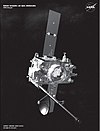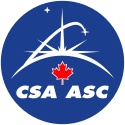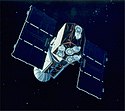Weltraumteleskop

Ein Weltraumteleskop ist ein Teleskop, das sich außerhalb der störenden Erdatmosphäre im Weltraum befindet. Vorteile des Weltraums für Teleskope sind fehlende Luftunruhe und Zugang zu von der Atmosphäre verschluckten Bereichen elektromagnetischer Strahlung wie Gammastrahlung, Röntgenstrahlung und Infrarotstrahlung. Zudem ermöglicht der Weltraum sehr lange Basislinien zum Beispiel in der Radiointerferometrie (siehe z. B. HALCA) oder für die Suche nach Gravitationswellen (siehe LISA).
Meist befinden sich Weltraumteleskope in einer Umlaufbahn um die Erde, neue Teleskope werden jedoch zunehmend an den Lagrange-Punkten der Erdbahn oder im Sonnenorbit positioniert. So befindet sich etwa das Sonnenobservatorium SOHO am inneren Lagrange-Punkt L1, von dem aus die Sonne ununterbrochen beobachtet werden kann. Die Sonde zur Erforschung der kosmischen Hintergrundstrahlung WMAP kreiste um den äußeren Lagrange-Punkt L2. Dort ist gleichzeitige Abschirmung störender Strahlung von Erde und Sonne einfacher. Das Spitzer-Weltraumteleskop wurde in einer Umlaufbahn um die Sonne eingesetzt.
Liste von Weltraumteleskopen
Diese Liste gibt eine Auswahl von Weltraumteleskopen wieder.
| Name | Bild | Start | Ende | Bereich | Betreiber | Ziele |
|---|---|---|---|---|---|---|
| RAE-A |  | 1968 | Radio | |||
| Uhuru (SAS-1) | 1970 | 1973 | Röntgen | |||
| OAO-3 (Copernicus) | 1972 | 1981 | UV, Röntgen | |||
| RAE-B |  | 1973 | 1977 | Radio | ||
| COS-B |  | 1975 | 1982 | Gamma | ||
| IUE |  | 1978 | 1996 | UV | ||
| IRAS |  | 1983 | 1983 | IR | ||
| Astron |  | 1983 | 1989 | UV, Röntgen | ||
| EXOSAT |  | 1983 | 1986 | Röntgen | ||
| ASTRO-C (Ginga) |  | 1987 | 1991 | Röntgen | ||
| COBE |  | 1989 | 1993 | Mikrowellen | Vermessung der Hintergrundstrahlung | |
| Hipparcos | 1989 | 1993 | Sichtbares Licht | Durchmusterung zur Erstellung eines Sternkatalogs | ||
| ROSAT | 1990 | 1999 | Röntgen | |||
| Hubble |  | 1990 | Sichtbares Licht, UV, IR | |||
| CGRO |  | 1991 | 2000 | Gamma | ||
| Yohkoh |  | 1991 | 2001 | Röntgen | ||
| EUVE |  | 1992 | 2001 | EUV | ||
| ASTRO-D (ASCA, Asuka) |  | 1993 | 2000 | Röntgen | ||
| ISO | 1995 | 1998 | IR | |||
| SOHO |  | 1995 | Sichtbares Licht, UV | |||
| RXTE |  | 1995 | 2012 | Röntgen | ||
| BeppoSAX |  | 1996 | 2002 | Röntgen | ||
| FUSE |  | 1999 | 2007 | UV | ||
| Chandra |  | 1999 | Röntgen | |||
| XMM-Newton | 1999 | Röntgen | ||||
| WMAP |  | 2001 | 2010 | Mikrowellen | Vermessung der Hintergrundstrahlung | |
| Integral | 2002 | Gamma | ||||
| GALEX |  | 2003 | 2013 | UV | ||
| Spitzer |  | 2003 | 2020 | IR | ||
| MOST | 2003 | 2019 | Sichtbares Licht | |||
| Swift |  | 2004 | Gamma | |||
| ASTRO-E (Suzaku) |  | 2005 | Röntgen | |||
| ASTRO-F (Akari) |  | 2006 | 2011 | IR | ||
| STEREO |  | 2006 | UV | |||
| COROT | 2006 | 2013 | Sichtbares Licht | Suche nach Exoplaneten mittels Transitmethode | ||
| AGILE | 2007 | Gamma | ||||
| Fermi |  | 2008 | Gamma | |||
| Kepler |  | 2009 | 2018 | Sichtbares Licht, IR | Suche nach Exoplaneten mittels Transitmethode | |
| Planck | 2009 | 2013 | Mikrowellen | Vermessung der Hintergrundstrahlung | ||
| Herschel |  | 2009 | 2012 für HFI | IR | ||
| WISE |  | 2009 | 2011 | IR | Suche dunkler Objekte wie Asteroiden und Brauner Zwerge in der Nähe des Sonnensystems | |
| RadioAstron (Spektr R) |  | 2011 | 2019 | Mikrowellen | ||
| NuSTAR |  | 2012 | Röntgen | |||
| NEOSSat | 2013 | Sichtbares Licht | ||||
| Gaia |  | 2013 | Sichtbares Licht | Durchmusterung zur Erstellung eines Sternkatalogs | ||
| ASTRO-H (Hitomi) |  | 2016 | Röntgen | |||
| HXMT | 2017 | Röntgen | ||||
| TESS |  | 2018 | sichtbares Licht, nahes IR | Suche nach Exoplaneten mittels Transitmethode | ||
| Spektr-RG |  | 2019 | Röntgen | Himmelsdurchmusterung in verschiedenen Energiebereichen. | ||
| CHEOPS | 2019 | Mithilfe der Transitmethode Größe, Masse und mögliche Atmosphären von bereits bekannten Exoplaneten (um helle, aber wenig aktive Sterne) zu bestimmen bzw. näher zu bestimmen | ||||
| IXPE |  | 2021 | Untersuchung von Schwarzen Löchern, Neutronensternen und Pulsaren | |||
| James Webb |  | 2021 | IR |
| ||
| Euclid | (c) ESA/C. Carreau, CC BY-SA 3.0 igo | 2023 | Sichtbares Licht, nahes IR | |||
| Einstein Probe | 2024 | Röntgen | Überwachung des gesamten Himmels mit Weitwinkelteleskop und Beobachtung von kurzen Ereignissen mit Präzisionsteleskop | |||
| SVOM |  | 2024 (geplant) | Röntgen, Gamma | Beobachtung von Gammablitzen und deren Nachglühen | ||
| Xuntian-Teleskop | 2024 (geplant) | UV, sichtbares Licht, nahes IR | Durchmusterung von 40 % des Himmels | |||
| SPHEREx | 2025 (geplant) | Nahes IR | Durchmusterung von Spektren von Galaxien | |||
| PLATO | (c) ESA, CC BY-SA IGO 3.0 | 2026 (geplant) | Sichtbares Licht | Suche nach Exoplaneten mittels Transitmethode | ||
| Nancy Grace Roman |  | 2027 (geplant) | Sichtbares Licht, nahes IR | |||
| ARIEL | (c) ESA, CC BY-SA IGO 3.0 | 2029 (geplant) | Sichtbares Licht und nahes IR | Charakterisierung der chemischen Zusammensetzung von Exoplaneten |

Privatprojekte
Um das Jahr 2012 kündigten mehrere private Raumfahrtunternehmen und Betreiber den Start und Einsatz von Weltraumteleskopen an.[2][3] Planetary Resources plante den Bau und Einsatz mehrerer Teleskope Arkyd-100 Leo Space Telescope zur Detektion von Asteroiden und anderen Objekten, die in Zukunft für Asteroidenbergbau geeignet sein könnten.[4] Die B612 Foundation plante den Start eines IR-Weltraumteleskopes Sentinel für das Jahr 2017, das für die Kartographierung und Früherkennung Erdnaher Objekte verwendet werden sollte.[5] Das deutsche Projekt Public Telescope kündigte den Start eines Weltraumteleskops für den ultravioletten und sichtbaren Spektralbereich ab 2019 an, welches neben der Wissenschaft auch von der Amateurastronomie sowie für die Bildung genutzt werden solle.[6] Die International Lunar Observatory Association kündigte für 2015 ein Observatorium in der Südpolregion des Monds an.[7] Stand April 2020 ist von diesen Projekte nur noch Letzteres aktiv, allerdings ohne konkreten Starttermin.
Das chinesische Unternehmen Origin Space startete am 11. Juni 2021 das kleine Weltraumteleskop Yangwang-1, das einen möglichen Asteroidenbergbau vorbereiten sollte.[8]
Siehe auch
Literatur
- Reinhard E. Schielicke: Astronomy with large telescopes from ground and space. Wiley-VCH, Weinheim 2002, ISBN 3-527-40404-X
- David Leverington: New cosmic horizons – space astronomy from the V2 to the Hubble Space Telescope. Cambridge Univ. Press, Cambridge 2000, ISBN 0-521-65137-9
- Zdeněk Kopal: Telescopes in space. Faber&Faber, London 1968
- Jingquan Cheng: Space Telescope Projects and their Development, S. 309ff. in: The principles of astronomical telescope design. Springer, New York 2009, ISBN 978-0-387-88790-6.
- Neil English: Space Telescopes - Capturing the Rays of the Electromagnetic Spectrum. Springer, Cham 2017, ISBN 978-3-319-27812-4.
Weblinks
- Paul Gilster: The Shape of Space Telescopes to Come. Centauri Dreams, 3. September 2015
Einzelnachweise
- ↑ RadioAstron, Lebedew-Institut für Physik, abgerufen am 30. August 2011.
- ↑ Sentinel: privates Weltraumteleskop zur Asteroidensuche, pro-physik.de
- ↑ Asteroid Mining Startup Planetary Resources Teams With Virgin Galactic, forbes.com
- ↑ Leo Space Telescope ( vom 1. Mai 2012 im Internet Archive), planetaryresources.com, abgerufen am 12. Juli 2012.
- ↑ B612 Sentinel Mission ( vom 16. Januar 2013 im Internet Archive), b612foundation.org
- ↑ Weltraumteleskop für jedermann, welt.de
- ↑ Kwame Opam: Moon Express unveils lunar lander design with planned 2015 launch date. In: The Verge. 8. Dezember 2013, abgerufen am 1. Mai 2019.
- ↑ 武亚姮: 长二丁一箭四星发射成功 北京三号卫星服务全球市场. In: spacechina.com. 11. Juni 2021, abgerufen am 11. Februar 2023 (chinesisch).
Auf dieser Seite verwendete Medien
Flagge des Vereinigten Königreichs in der Proportion 3:5, ausschließlich an Land verwendet. Auf See beträgt das richtige Verhältnis 1:2.
Flagge des Vereinigten Königreichs in der Proportion 3:5, ausschließlich an Land verwendet. Auf See beträgt das richtige Verhältnis 1:2.
Autor/Urheber:
Canadian Space Agency
, Lizenz: LogoLogo der Canadian Space Agency
Autor/Urheber: NASA on The Commons, Lizenz: No restrictions
Image Credit: NASA/ISAS/JAXA
Description Suzaku (Astro-E2): launched July 10, 2005. The Suzaku satellite was created to study objects such as black holes, neutron stars and supernova.
It has also been used to research elements of supernova debris, as well as how a black hole bends light.International Ultraviolet Explorer
Autor/Urheber: 掬茶, Lizenz: CC BY-SA 4.0
太陽観測衛星『ようこう』模型(1/10スケール)
(c) ESA, CC BY-SA IGO 3.0
ESA’s trifecta of dedicated exoplanet missions – Cheops, Plato and Ariel – will also be complemented with the upcoming James Webb Space Telescope mission.
The Characterising Exoplanet Satellite, Cheops, was launched in December 2019 and is observing bright stars known to host exoplanets, in particular Earth-to-Neptune-sized planets. It is recording the precise sizes of these relatively small planets and combined with mass measurements already calculated from other observatories, will enable the planet's density to be determined, and thus make a first-step characterisation of the nature of these worlds. Cheops will also identify candidates for additional study by future missions. For example, it will provide well-characterised targets for the international James Webb Space Telescope launching in December 2021, which will perform further detailed studies of their atmospheres.
Plato, the PLAnetary Transits and Oscillations of stars mission, is a next-generation planet hunter with an emphasis on the properties of rocky planets in orbits up to the habitable zone around Sun-like stars – the location from a star where liquid water can exist on the planet's surface. Importantly, it will also analyse the planet's host star, including its age, and thus give insight into the evolutionary state of the entire extrasolar system.
Ariel, the Atmospheric Remote-Sensing Infrared Exoplanet Large-survey mission, will perform a chemical census of a large and diverse sample of exoplanets by analysing their atmospheres in great detail, finally answering still open questions like: What are exoplanets made of, how do planets and planetary systems form, and how do planets and their atmospheres evolve?
With the complementary work of both ground- and space-based observatories, we will get closer to understanding one of humanity's biggest questions: are we alone in the Universe?
An STS-125 crewmember aboard the Space Shuttle Atlantis captured this still image of the Hubble Space Telescope as the two spacecraft continue their relative separation on May 19, after having been linked together for the better part of a week.
Autor/Urheber: DLR German Aerospace Center, Lizenz: CC BY 2.0
Die Mission soll die größte dreidimensionale Karte unserer Galaxie erstellen / The mission will create the largest, most precise three-dimensional map of our Galaxy to date by surveying an one percent of 100 billion stars.
logo of Japan Aerospace eXploration Agency, JAXA
Artist concept of the Transiting Exoplanet Survey Satellite with black background.
FUSE satellite
Autor/Urheber: Pline, Lizenz: CC BY-SA 3.0
Model of Spektr-RG russian X-ray space telescope by Roscosmos at the 2011 Paris Air Show.
Autor/Urheber: 掬茶, Lizenz: CC BY-SA 4.0
赤外線天文衛星『あかり』模型(1/10スケール)
The Hubble Space Telescope (HST) begins its separation from Space Shuttle Discovery following its release on mission STS-82. Cropped version of File:Hubble 01.jpg
WFIRST rendering released by NASA in May 2020
A large picture of Exosat
Logo of the Russian Federal Space Agency, commonly called Roscosmos, and abbreviated as FKA and RKA.
BeppoSax X-ray satellite. Courtesy of the Agenzia Spaziale Italiana (ASI) and the BeppoSAX Science Data Center (SDC).
Artist's concept of NuSTAR on orbit. NuSTAR has a 10-m (30') mast that deploys after launch to separate the optics modules (right) from the detectors in the focal plane (left). The spacecraft, which controls NuSTAR's pointings, and the solar panels are with the focal plane. NuSTAR has two identical optics modules in order to increase sensitivity. The background is an image of the Galactic center obtained with the Chandra X-ray Observatory.
EUVE (Extreme Ultra Violet Explorer)
WISE (Wide-Field Infrared Survey Explorer)
Autor/Urheber: 掬茶, Lizenz: CC BY-SA 4.0
X線天文衛星『あすか』模型(1/10スケール)
Logotype of the European Space Agency (ESA). Intended for use at small sizes only, but the official, more detailed one seems eligible for copyright.
Artist's impression of the Herschel Space Observatory
(c) Photograph by Mike Peel (www.mikepeel.net)., CC BY-SA 4.0
Model of the Planck Satellite. Photographed at the Royal Astronomical Society's National Annual Meeting 2009.
an artistic concept of the comptom observatory
Artist's rendering, from NASA, of the European Space Agency's INTEGRAL spacecraft, in its in-flight configuration. The INTEGRAL mission, short for the "International Gamma-Ray Astrophysics Laboratory", is focused on Gamma-ray astronomy, making use of a medium-sized Gamma-ray space observatory to make observations on astronomical Gamma-ray sources and collect data for study.
Illustration of the James Webb Space Telescope, current as of September 2009. Top side.
(c) Photograph by Mike Peel (www.mikepeel.net)., CC BY-SA 4.0
Model of the AGILE satellite
Artist's Concept of Infrared Astronomical Satellite
Computer rendering of the Swift spacecraft
Some space observatories (+3 ground based surveys) and their wavelength working ranges. Blue bars indicate past or current missions, and green bars those in development, all as of 2005.
Imaging X-ray Polarimetry Explorer: X-ray space telescope of NASA
COS-B satellite
NASA-created illustration of the WMAP spacecraft, with background
Schéma du télescope spatial ASTRO-H
(c) ESA/C. Carreau, CC BY-SA 3.0 igo
Euclid is an ESA mission to map the geometry of the dark Universe. Euclid will investigate the distance-redshift relationship and the evolution of cosmic structures. It achieves this by measuring shapes and redshifts of galaxies and clusters of galaxies out to redshifts ~2, or equivalently to a look-back time of 10 billion years. It will therefore cover the entire period over which dark energy played a significant role in accelerating the expansion. The Euclid spacecraft will have a launch mass of around 2100 kg. It will be about 4.5 metres tall and 3.1 metres in 'diameter' (with appendages stowed). The nominal mission lifetime is six years.
Artist illustration of the Chandra X-ray Observatory. Chandra is the most sensitive X-ray telescope ever built.
Artist's concept of the Cosmic Background Explorer (COBE) spacecraft, the predecessor to the WMAP Project. COBE was launched by NASA into an Earth Orbit in 1989 to make a full sky map of the Cosmic Microwave Background (CMB) radiation leftover from the Big Bang. The first results were released in 1992. COBE's limited resolution (7 degree wide beam) provided the first tantilising details in a full sky image of the CMB.
Artist's rendering of the European Space Agency's XMM-Newton spacecraft, in its in-flight configuration. The XMM-Newton mission, short for "X-ray Multi-mirror Mission" focuses on X-ray astronomy, making use of a large, multi-mirror X-ray space observatory to carry out observations and data collection.
Autor/Urheber: Pline, Lizenz: CC BY-SA 4.0
Maquette du radiotélescope spatial russe RadioAstron (Spektr-R), Salon du Bourget 2015
RXTE - Rossi X-Ray Timing Explorer
(c) ESA, CC BY-SA IGO 3.0
ESA’s trifecta of dedicated exoplanet missions – Cheops, Plato and Ariel – will also be complemented with the upcoming James Webb Space Telescope mission.
The Characterising Exoplanet Satellite, Cheops, was launched in December 2019 and is observing bright stars known to host exoplanets, in particular Earth-to-Neptune-sized planets. It is recording the precise sizes of these relatively small planets and combined with mass measurements already calculated from other observatories, will enable the planet's density to be determined, and thus make a first-step characterisation of the nature of these worlds. Cheops will also identify candidates for additional study by future missions. For example, it will provide well-characterised targets for the international James Webb Space Telescope launching in December 2021, which will perform further detailed studies of their atmospheres.
Plato, the PLAnetary Transits and Oscillations of stars mission, is a next-generation planet hunter with an emphasis on the properties of rocky planets in orbits up to the habitable zone around Sun-like stars – the location from a star where liquid water can exist on the planet's surface. Importantly, it will also analyse the planet's host star, including its age, and thus give insight into the evolutionary state of the entire extrasolar system.
Ariel, the Atmospheric Remote-Sensing Infrared Exoplanet Large-survey mission, will perform a chemical census of a large and diverse sample of exoplanets by analysing their atmospheres in great detail, finally answering still open questions like: What are exoplanets made of, how do planets and planetary systems form, and how do planets and their atmospheres evolve?
With the complementary work of both ground- and space-based observatories, we will get closer to understanding one of humanity's biggest questions: are we alone in the Universe?
Artist rendering of the Fermi Gamma-ray Space Telescope.






































































